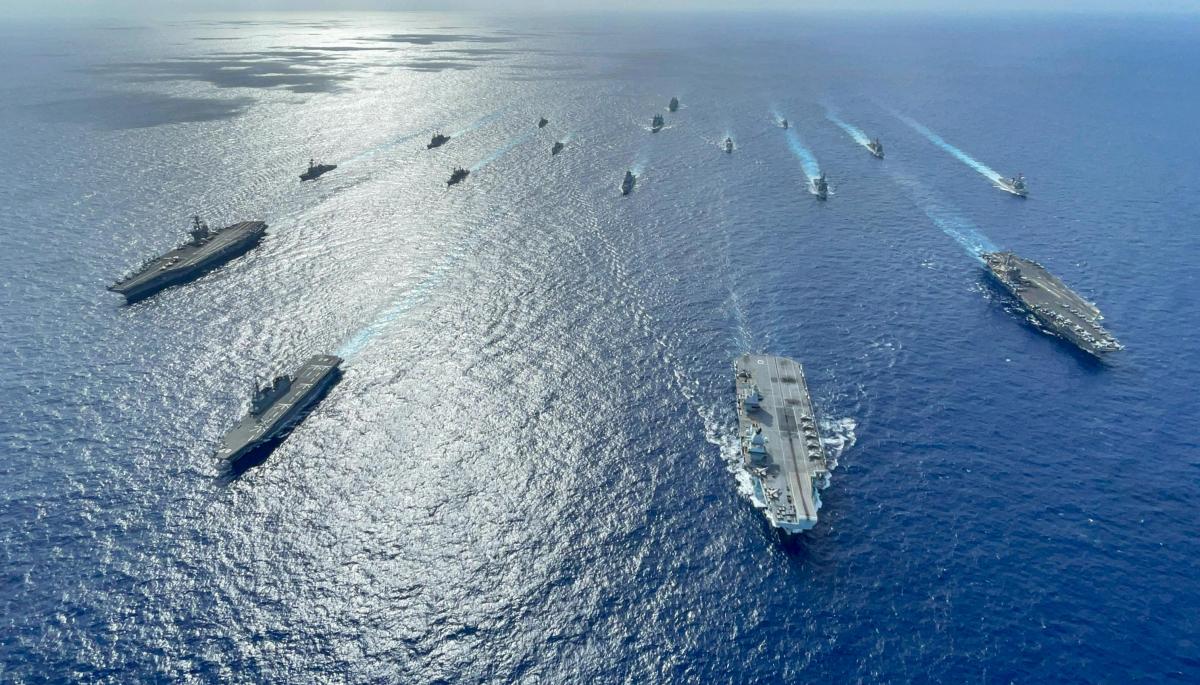A New Zealand Navy frigate is sailing through the disputed South China Sea as tensions between China and Taiwan escalate.
The Defence Force on Wednesday morning said the Royal New Zealand Navy Frigate Te Kaha is joining the United Kingdom's Carrier Strike Group (CSG) - which includes the massive HMS Queen Elizabeth - and other military partners to transit through the South China Sea.
Te Kaha and the replenishment tanker HMNZS Aotearoa set off from Auckland's Hauraki Gulf in September to interact with other nations in the Indo-Pacific. That includes for the Bersama Gold 21 exercise to mark the 50th anniversary of the Five Power Defence Arrangement (FPDA), of which New Zealand is a partner alongside Australia, Malaysia, Singapore and the UK.

HMNZS Te Kaha berthed at Davenport Naval Base
The HMNZS Aotearoa has just finished its time with HMS Queen Elizabeth conducting exercises off the coast of Guam and "now it is HMNZS Te Kaha's turn as the frigate enters the South China Sea".
The waters are an area of major contention for surrounding countries. China claims much of the sea as its own, building artificial islands there and warning others not to sail close to what it refers to as its territory. Other nations have contested China's expansion and, in 2016, the Hague rejected China's historical claims.
READ MORE
- CSG21: New Zealand Navy Exercises With Strike Group
- HMNZS Aotearoa & CSG21
- HMNZS Aotearoa, HMNZS Te Kaha & USS Charleston
- HMNZS Te Kaha joins UK Carrier Strike Group in South China Sea
New Zealand, as recently as August, has said there is no "legal basis for states to 'claim historic rights' with respect to maritime areas in the South China Sea", "no legal basis for continental states to claim archipelagic status", and that artificial islands "do not generate a territorial sea of their own".
Those comments were made in a diplomatic note in which New Zealand reiterated "that it does not take a position on competing claims of territorial sovereignty" in the waters. It also doesn't specifically name China.
In May, Prime Minister Jacinda Ardern and Australian Prime Minister Scott Morrison jointly "expressed serious concern over developments in the South China Sea, including the continued militarisation of disputed features and an intensification of destabilising activities at sea". China's Foreign Affairs Ministry spokesperson Wang Wenbin called these and other remarks by the pair "irresponsible".
China, often through its state media, has made a number of threats towards other nations seeking to travel through the South China Sea. In July, as HMS Queen Elizabeth sailed the waters, the Global Times said the ship should stick to what China says are international waters or face a "confrontation".

The New Zealand Defence Force on Wednesday said it has operated in the South East Asia region "for decades as part of bilateral and regional defence engagement, and demonstrates its commitment to regional security through its presence in the region".
"The South China Sea is one of the world's major sea lanes and is routinely transited by merchant and naval vessels and aircraft."
"NZDF deployments exercise freedom of navigation and overflight. The NZDF undertakes all activities in accordance with international law, and for ships in particular the United Nations Convention on the Law of the Sea," it says.
"The South China Sea is one of the world's major sea lanes and is routinely transited by merchant and naval vessels and aircraft."
Defence Minister Peeni Henare last month said he has "no concern" around New Zealand having ships in the region.
The HMNZS Aotearoa is now enroute to Singapore for the Bersama Gold 21 exercise, which HMNZS Te Kaha will join after a week with the CSG. A New Royal New Zealand Air Force P-3K2 Orion will also join the exercise, which the Defence Force says is "designed to enhance interoperability and strengthen relationships" between militaries. About 270 personnel have been deployed across the two ships.
Bersama Gold 21, held off the coast of Singapore and the Malaysian Peninsula, will see FPDA defence forces "in the conduct of Combined and Joint Operations in a multi-threat environment".
"The exercise will commence with Force Integration Training and conclude with a War-at-Sea exercise," the Defence Force said last month.

Te Kaha's transit comes in the wake of Taiwan's Foreign Minister Joseph Wu warning if China was to launch "an attack", "we will fight to the end". China, which claims Taiwan as its own, has sent about 150 aircraft into the island's Air Defence Identification Zone since Friday, raising questions about Beijing's intentions.
Wu called for "like-minded partners", such as Australia, to partake in "security or intelligence exchanges".
Australia responded on Monday night, expressing concern about China's actions and urging the resolution of differences to be "achieved peacefully through dialogue and without the threat or use of force or coercion".
Wu's comments were followed by an essay on Tuesday by Taiwan's leader Tsai Ing-wen, who said if Taiwan "were to fall, the consequences would be catastrophic for regional peace and the democratic alliance system".
She said Taiwan was "committed to collaborating with our neighbours to prevent armed conflict in the East China and South China Seas as well as in the Taiwan Strait".
The island's leaders will this week meet with former Australian Prime Minister Tony Abbott, who last week spoke in support of Taiwan's bid to join the Comprehensive and Progressive Agreement for a Trans-Pacific Partnership (CPTPP), which China opposes. New Zealand received applications from both China and Taiwan last month to join the agreement.
Concern about a potential war in the region has been mounting all year, with both Australian and American officials saying conflict could not be discounted. Australia, the United States, and the United Kingdom last month unveiled a new security pact - AUKUS - aimed at confronting emerging threats in the Indo-Pacific, with an eye on China.






